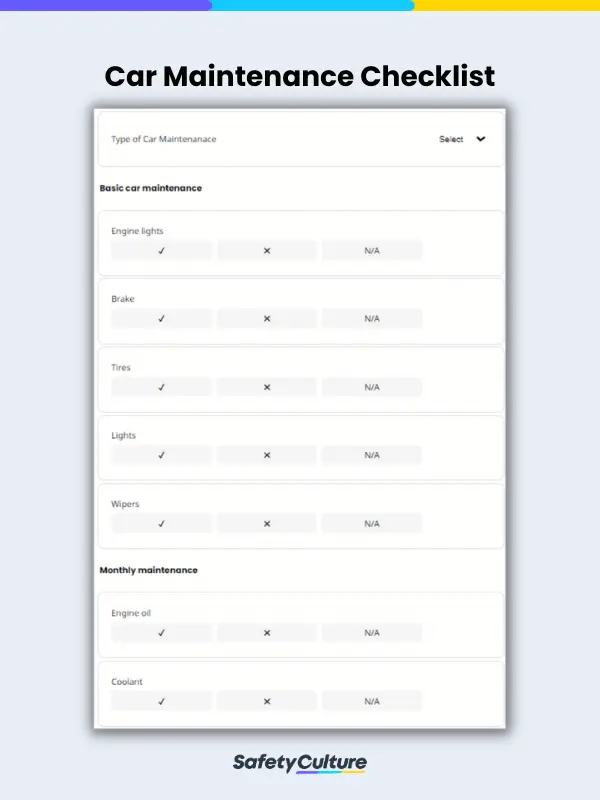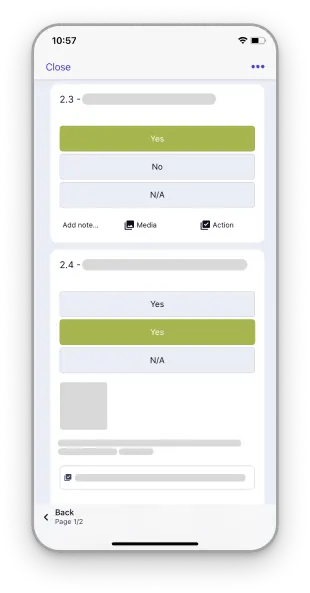Car maintenance is a proactive approach to preserve and maximize the performance of a vehicle. It is performed by car service technicians or fleet managers to prevent unexpected machine breakdowns that may lead to car incidents, property damage, or costly repairs.
Why Is It Important?
Car maintenance is a crucial task, especially to fleet and service industries. It keeps vehicles running smoothly to avoid any operational delays and disruptions. Carrying out regular car maintenance helps businesses to:
- address car issues even before they arise;
- increase employee safety while on the road;
- reduce the probability of car breakdown that may cause vehicle damages; and
- save time and money on unexpected auto repairs.
What is a Car Maintenance Checklist?
A car maintenance checklist is a tool used by auto service technicians to keep track of car service schedules and eliminate unexpected defects and engine breakdowns. It helps prolong the operational condition of a vehicle, ensure roadworthiness, and promote safety by proactively catching issues before accidents can occur.
Auto Parts That Need Inspection Based on The Schedule
Car maintenance may vary depending on the needs of a vehicle. It can be performed regularly, monthly, or based on accumulated mileage. The following maintenance schedule can help to identify vehicle parts or items that need to be inspected.
Basic Maintenance
Basic car maintenance can keep the vehicle running smoothly by visually checking the following items:
- Engine lights – flashing engine lights is a sign that the electronic control system has run into a problem that needed immediate attention.
- Brake – manually test brakes if there is a spongy feels or if it takes more pressure to apply the brakes than normal. Check if you can hear a strange reak sound.
- Tires – check if the tire pressure light is “on” and inspect if the pressure is in a normal range. Visually investigate for a possibility of tire holes.
- Lights – test for busted lights including the head, tail, parking, brake, and signal lights.
- Wipers – check wiper blades for any signs of wear and tear and replace them if necessary.
Monthly Maintenance
Monthly maintenance can keep the vehicle tuned up by replacing consumable items such as gas, oil, and other lubricants. It is important to check the following items monthly:
- Engine oil – check the difference between the “low” and “full” markings using a dipstick. Replenish the engine oil if below markings.
- Coolant – verify the level at the reservoir and fill up the coolant up to normal level.
- Windshield wiper fluid – go through the level and top off if needed.
Every 3 months or 3,000 Miles
When 3,000 miles is reached or after three months, whichever comes first, perform car maintenance and replace the following items according to the recommendation of manufacturers.
- Automatic transmission fluid – check the level of transmission fluid, if it is low, add the appropriate transmission fluid type.
- Power steering fluid – inspect the system for leaks, especially if topping off becomes frequent.
- Engine air filter – replace the air filter if it is dirty, full of debris, or having discolorations.
- Battery – check the battery if mounted securely and free from corrosion.
- Belts – replace frayed or worn V-belts and serpentine belts.
- Hoses – check if hoses are brittle, have leaks, or cracks then replace accordingly.
- Exhaust – listen to exhaust systems and check if there is a strange noise. Check for leaks or damage.
- Tire treads – replace the tire if the tire tread depth is 2/32” or less.
Every 6 months or 6,000 Miles
When 6,000 miles is reached or after six months, whichever comes first, rotate your tires to extend their service life. Also, check the following items:
- Engine oil and filter – Change engine oil and filter as it accumulates tiny bits of metal, dirt, and carbon over time that can cause excessive wear on the engine.
- Chassis, steering, and suspension systems – lubricate these parts as needed.
- Brake systems – Inspect the whole system including brake fluid, brake linings, rotors, and pads.
- Spark plugs – look for busted plugs and replace them if necessary.
- Timing belt – Replace the timing belt if there are signs of wear and tear.
- Shocks and struts – Check if there is a decrease in smoothness or loss of control when driving.
How does a Checklist Help?
A car maintenance checklist helps identify issues, defects, or any problem that arises on a vehicle. It helps secure vehicle roadworthiness to promote safety and operational efficiency.
Prioritizing car parts that need to be inspected depending on schedule will eliminate wasting time on checking the items that you don’t need to inspect at the moment. A car maintenance checklist can depend on car needs or the maintenance schedule.
3 Essential Tips
Failure to implement effective car maintenance or auto repair system can result in less business and more customer complaints. To help avoid these, here are essential car maintenance tips for both automotive technicians and auto repair shop managers:
1. Perform Checks Consistently
Automotive technicians can usually tell if a car is likely to have problems through routine maintenance. A general maintenance check of the car, along with separate checks for each car function, can be scheduled to ensure that potential issues are caught before they become real problems.
Car maintenance software enables auto repair shop managers to assign checks to select automotive technicians. Scheduled maintenance checks have a “start at” and “complete by” time, and auto repair shop managers are automatically informed when a scheduled car maintenance check is completed or missed. Recurring maintenance checks can be scheduled for general and specific assessments to ensure that nothing is missed. Aside from scheduling car maintenance, auto repair shop managers can monitor the number of failed items and the status of corrective actions. Auto repair shop managers can also set reminders to ensure that maintenance tasks are performed and completed on time.
2. Pay Attention to Details
Car maintenance needs to be taken seriously as it is critical to the safety of the car owners and the reputability of the auto repair shop. Managers need to ensure that maintenance checks are completed correctly. This means no skipped items, no rushed assessments, and no vague observations. By including photos, annotations, and notes, automotive technicians get a comprehensive view of the car’s condition.
Approaches to car maintenance can differ by vehicle or auto repair shop. Whichever way is best, car maintenance software allows the process to be customized according to car manufacturer specifications or however the automotive technician sees fit. With car maintenance software, auto repair shop managers can set specific response types for automotive technicians to fill. By using car maintenance software, auto repair shop managers get the information they need and automotive technicians spend less time figuring out how to conduct an inspection.
3. Take a Systematic Approach
Aside from addressing isolated issues as they appear, auto repair shop managers can use the data gathered from maintenance checks to recognize recurring problems and resolve them at the root. For example, if there are customer complaints regarding tire failures, a review of the auto repair shop’s collective data could reveal that this issue occurs frequently when the tire’s tread depth has dipped below average due to wear and tear. This and other data gathered by maintenance software can be very helpful when inspecting a large number of cars daily.
Data from individual car maintenance checks can be synced in real-time using a software solution. Auto repair shop managers can review and analyze their findings through analytics so that they know which issues need to be addressed. Analytics can provide a visual overview of car maintenance using a single dashboard. Auto repair shop managers can even filter information to review data specific to location, time, and automotive technician to pinpoint problems early.
Using a Software in the Auto Repair Industry
The auto repair industry faced serious challenges in 2020, with a projected loss of $1.8 billion from economic disruptions caused by the pandemic. However, the auto repair industry is expected to recover this year, with 18% of American households using an auto repair service and a compound annual growth rate (CAGR) of 7%. The global auto repair and maintenance market may even reach $828.6 billion in 2023, from $691.7 billion in 2020 and $693.5 billion in 2019.
While it can be tempting to just sit back and relax with such a bright future ahead, auto repair shops should still be vigilant in understanding new tools and trends. As with other industries, technology is increasingly becoming more and more integrated into how auto repair shops work. Car maintenance companies are using IoT to get real-time data on components through sensors in vehicles. Another industry trend is telematics, which collects and transmits data on vehicle use, maintenance requirements, and automotive servicing. Software can help auto repair shops adapt to both of these trends by allowing automotive technicians to conduct routine checks and inspections from within a digital system that can be connected to sensors and other smart devices.
While IoT and telematics are examples of trends that can help the auto repair industry grow, there are several trends that may hurt the industry’s outlook such as increased vehicle leasing and a growing preference for having dealerships handle repairs. Auto repair shops can soften the effects of these two trends by partnering with dealerships that lease and repair automobiles and by using car maintenance software to promote and manage client relations. Communicating the value of their work to customers can help bolster the position of auto repair shops amidst a changing and competitive market.



